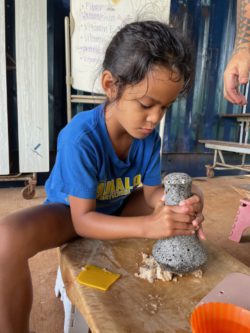Fresh Veggies a Hit with Molokai Students
By Paul Hanley, Community Reporter

Photo by Kristina Cacpal.
A small group of fifth and sixth grade students assemble outside the gate of the school garden in Maunaloa. They chant an oli written specifically for the ahupua’a of Kaluako’i. Their kumu, Wendy Espaniola, responds, inviting them to enter.
The students, each holding a clip board, scatter around the garden and sit down to begin their kilo. Taking their time, sitting in silence, they look up, down, and around and record their observations. They then assemble to share often subtle reflections, about cloud patterns, the color of the sea, the movement of insects, and the need to weed the garden.
Extra time is given to the kilo because they are preparing for a field trip to the forest in a few days and will be expected to make detailed observations, including taking soil samples.
Maunaloa’s school garden project is a part of a concerted effort to connect Molokai’s children and youth to local food production and healthy eating. Recently, Kristina Cacpal has been hired by the University of Hawaii as a farm-to-school extension agent to intensify this effort.
“The schools tell us what they need, whether it’s gardening or nutrition education, access to fresh food or connecting with local farmers,” says Cacpal. “Each school has its own objectives. Right now, Maunaloa needs support getting kalo in the ground.
“Kalo is a big thing,” continues Cacpal. “The kids plant and care for six varieties, weed the beds, harvest the leaves, make luau stew, harvest the corm, steam and pound it to make poi, and replant the huli. They are becoming accustomed to the practices Hawaiians have carried on for so long.”
The school program at Maunaloa follows a curriculum developed by the Kohala Center on Hawaii Island. It explores four themes: sense of place, living soils, nourishment, and systems and nature’s design. It incorporates Hawaiian culture and integrates state standards in math, reading and writing. For example, the students used math to calculate the area of the boards used in the garden construction projects, figured out the amount of paint needed, then did the painting themselves.
“Because we are diverse here, we also support learning about other culturally important foods,” says Cacpal. “We have made kim chi from our garden produce, for example, and grown foods that are typically part of Filipino cooking.”

Photo by Kristina Cacpal.
“At Kilohana School, they wanted to plant starters, cucumbers, kale, peppers and so on, that go home to the families for their gardens,” she explains. “They also planted flowers for Mother’s Day. At the high school, the students are working on a farm plan and designing a composting system.”
When asked if they really like vegetables, the Maunaloa students responded with an enthusiastic “yes”—to fresh vegetables from the garden, that is, not so much the canned vegies in their school lunches.
Three other programs will help children get more of the fresh kind, says Cacpal, who will be working with Sust’ainable Molokai on a fresh fruit and vegetables program. Sust’ainable will provides the produce. She will bring samples to school for tasting and teach the kids about the nutritional benefits.
Another goal is to incorporate locally grown fresh vegetables in school cafeteria lunches. In 2021, the state set a goal that will require public schools to source 30 percent of food they serve to students from local sources. Kapiolani Community College on Oahu developed a program for school cafeteria managers on incorporating locally grown food, especially staples such as sweet potato.
“We also need more teachers to get involved,” reports Cacpal, “but they need support, so a program has been started for teachers to learn more about gardening. The next program will be the first week in June. Teachers get professional credits and the program is also open to home schooling parents.”
Food and farming programs for Molokai students offer more than practical learning. They invite children into a growing movement for food sovereignty. One of the most interesting projects undertaken by the Maunaloa students was the production of a video about one of their projects, making compost tea.
“The students created the script themselves,” says Cacpal. “One pretended they knew nothing and asked a lot of questions. The others played the experts. The goal was to teach what was taught to them, but in their own words, and to make it entertaining as well as informative. Their personalities really shine though.”
The video will be posted on the UH Molokai Extension YouTube, which is loaded with informative locally made food and farming videos: youtube.com/@uhmolokaiextension6961/videos.
Creative efforts like Molokai’s farm-to-school program help achieve the ultimate goal of farming, which as the renowned farmer-philosopher Masanobu Fukuoka put it, “is not the growing of crops but the cultivation and perfection of human beings.”











Don't have a Molokai Dispatch ID?
Sign up is easy. Sign up now
You must login to post a comment.
Lost Password